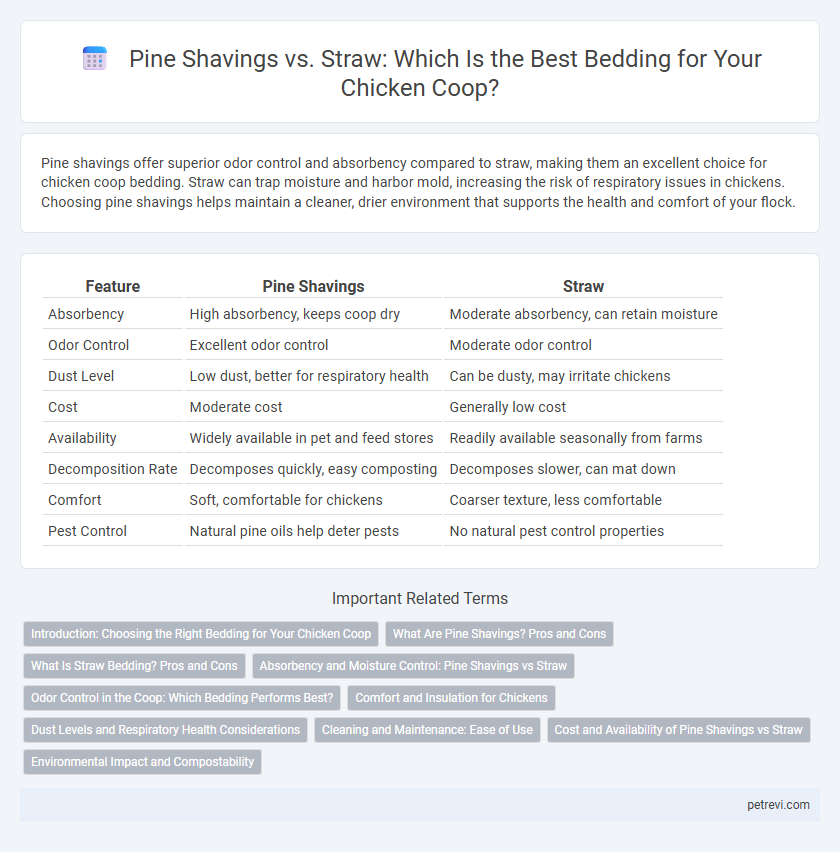Pine shavings offer superior odor control and absorbency compared to straw, making them an excellent choice for chicken coop bedding. Straw can trap moisture and harbor mold, increasing the risk of respiratory issues in chickens. Choosing pine shavings helps maintain a cleaner, drier environment that supports the health and comfort of your flock.
Table of Comparison
| Feature | Pine Shavings | Straw |
|---|---|---|
| Absorbency | High absorbency, keeps coop dry | Moderate absorbency, can retain moisture |
| Odor Control | Excellent odor control | Moderate odor control |
| Dust Level | Low dust, better for respiratory health | Can be dusty, may irritate chickens |
| Cost | Moderate cost | Generally low cost |
| Availability | Widely available in pet and feed stores | Readily available seasonally from farms |
| Decomposition Rate | Decomposes quickly, easy composting | Decomposes slower, can mat down |
| Comfort | Soft, comfortable for chickens | Coarser texture, less comfortable |
| Pest Control | Natural pine oils help deter pests | No natural pest control properties |
Introduction: Choosing the Right Bedding for Your Chicken Coop
Pine shavings provide excellent absorbency and odor control, making them a popular choice for chicken coop bedding. Straw offers natural insulation and is often more affordable, but can retain moisture longer and support mold growth. Selecting bedding requires balancing factors such as moisture management, comfort, and cost to ensure a healthy environment for chickens.
What Are Pine Shavings? Pros and Cons
Pine shavings are soft, absorbent wood shavings commonly used as chicken coop bedding, known for controlling odor and moisture effectively. They provide excellent insulation and are less dusty than some alternatives, reducing respiratory issues in chickens. However, pine shavings can be more expensive than straw and require regular cleaning to prevent ammonia buildup.
What Is Straw Bedding? Pros and Cons
Straw bedding, made from dried stalks of cereal plants, is commonly used in chicken coops for its insulation properties and natural composition. It provides good warmth and is biodegradable, making it an eco-friendly option, but it tends to retain moisture, which can lead to mold growth and ammonia buildup if not regularly cleaned. Despite these drawbacks, straw is lightweight, affordable, and offers a comfortable surface for chickens to nest and roost.
Absorbency and Moisture Control: Pine Shavings vs Straw
Pine shavings offer superior absorbency and moisture control compared to straw, effectively wicking away dampness and reducing ammonia buildup in chicken coops. Straw tends to retain moisture longer, increasing the risk of mold and bacterial growth that can harm flock health. Choosing pine shavings enhances coop dryness, promoting a healthier environment and lowering respiratory issues among chickens.
Odor Control in the Coop: Which Bedding Performs Best?
Pine shavings excel in odor control for chicken coops due to their natural antimicrobial properties and high absorbency, effectively reducing ammonia buildup from droppings. Straw, while traditional and inexpensive, tends to retain moisture and odors longer, leading to a less hygienic environment. Choosing pine shavings enhances air quality and promotes healthier conditions for chickens by minimizing foul smells more efficiently.
Comfort and Insulation for Chickens
Pine shavings provide superior comfort and insulation for chicken coop bedding due to their fine texture and ability to retain warmth, which helps keep chickens cozy during cold weather. Straw, while offering good insulation, tends to be coarser and less absorbent, potentially leading to damp conditions that reduce overall comfort. Proper bedding choice impacts chicken health and behavior, with pine shavings often preferred for maintaining dry, warm, and comfortable nesting areas.
Dust Levels and Respiratory Health Considerations
Pine shavings offer lower dust levels compared to straw, reducing respiratory irritation and improving overall air quality in chicken coops. Straw tends to accumulate more dust and mold spores, which can trigger respiratory issues such as chronic respiratory disease in chickens. Choosing pine shavings enhances respiratory health by minimizing airborne particles and providing a cleaner environment for poultry.
Cleaning and Maintenance: Ease of Use
Pine shavings are highly absorbent and control odors effectively, making cleaning and maintenance easier by reducing moisture buildup in the coop. Straw tends to retain more moisture and can become compacted, leading to more frequent bedding changes and increased effort in cleaning. Choosing pine shavings enhances ease of use through longer-lasting cleanliness and simpler daily maintenance routines.
Cost and Availability of Pine Shavings vs Straw
Pine shavings are generally more expensive than straw but offer superior absorption and odor control, making them a popular choice for chicken coop bedding. Straw is often cheaper and more widely available, especially in rural areas, but it tends to retain moisture and harbor bacteria if not changed frequently. Availability of pine shavings can vary by region, whereas straw is typically plentiful during harvest seasons.
Environmental Impact and Compostability
Pine shavings offer superior compostability due to their high absorbency and natural resin content, which helps control odor and accelerates breakdown in compost piles. Straw, while biodegradable, decomposes slower and may harbor mold spores, posing environmental risks to coop air quality and soil health. Choosing pine shavings enhances sustainable poultry bedding management by minimizing waste impact and promoting nutrient-rich compost for gardening.
Pine Shavings vs Straw for Chicken Coop Bedding Infographic

 petrevi.com
petrevi.com